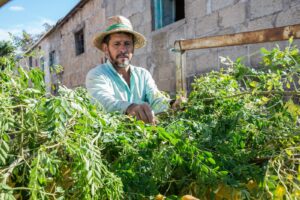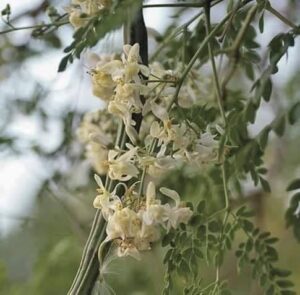Moringa Seeds – How to Plant
Discover the enchanting world of moringa seeds in this comprehensive guide, where we’ll walk you through the process of planting these “miracle seeds.” Originating from the Moringa oleifera tree, moringa seeds offer immense potential for culinary and health purposes. By planting them, you can harness their remarkable qualities and experience their numerous benefits.
Moringa seeds are not only a source of nourishment but also a valuable addition to any garden or home. They boast an incredible nutritional profile, packed with essential vitamins, minerals, and antioxidants. Incorporating moringa into your diet can enhance your overall well-being and elevate your culinary creations.
What sets growing moringa at home apart is its adaptability and sustainability. Moringa trees thrive in diverse environments and contribute to a greener planet. Whether you have a spacious backyard or a cozy balcony, planting moringa seeds allows you to make a positive impact while reaping the rewards of this remarkable plant.
Throughout this guide, we’ll take you on a step-by-step journey to successfully plant moringa seeds. From selecting high-quality seeds to creating an optimal growing environment, nurturing the seedlings, and safeguarding them from pests and diseases, we’ll provide all the information you need. Additionally, you’ll learn the art of pruning and shaping moringa trees and experience the joy of harvesting their pods and seeds.
As you delve into the process of planting moringa seeds, you’ll also uncover the fascinating culinary and health benefits they offer. From delightful recipes to traditional uses, moringa seeds provide a wealth of flavor and wellness opportunities.
Getting Started: Selecting and Preparing the Seeds

Before embarking on your moringa planting journey, it’s crucial to start with high-quality seeds. In this section, we will explore the essential steps of selecting and preparing moringa seeds for optimal germination and successful growth.
A. Obtaining high-quality moringa seeds: When it comes to moringa seeds, quality matters. Look for reputable suppliers or nurseries that specialize in moringa plants. Ensure that the seeds are fresh, as they tend to lose viability over time. It’s ideal to choose seeds from healthy, mature moringa trees, as they are more likely to produce vigorous seedlings.
B. Properly storing and preserving seeds: To maintain the viability of your moringa seeds, proper storage is crucial. Store them in a cool, dry place, away from direct sunlight and extreme temperature fluctuations. Airtight containers or sealed plastic bags can help protect the seeds from moisture and pests. Remember to label and date the containers for future reference.
C. Pre-soaking seeds for optimal germination: Pre-soaking moringa seeds can significantly enhance their germination rate. Fill a container with warm water and place the seeds inside, ensuring they are fully submerged. Allow them to soak for 24 to 48 hours, periodically changing the water to prevent stagnation. Pre-soaking helps soften the seed coat, promoting quicker and more uniform germination.
By taking the time to select high-quality seeds and properly prepare them, you set the stage for a successful moringa planting experience. The quality of your seeds plays a vital role in determining the health and vigor of your future moringa plants.
In the next section, we will delve into creating the perfect growing environment for your moringa seeds. From choosing the right location to preparing the soil, we’ll cover everything you need to know to ensure your moringa plants thrive. So let’s continue this journey and unlock the secrets to successful moringa seed planting!
Creating the Perfect Growing Environment
Creating an optimal growing environment is vital for the successful cultivation of moringa seeds. In this section, we will explore the key factors to consider when establishing the perfect habitat for your moringa plants to thrive.
A. Choosing the right location for planting: Selecting the right location is crucial for the healthy growth of your moringa plants. Ideally, choose a spot that receives full sunlight for at least six hours a day. Moringa trees thrive in warm climates, so ensure the chosen location offers adequate warmth throughout the growing season. If you live in a cooler region, consider planting moringa in containers that can be moved indoors during colder periods.
B. Preparing the soil for moringa cultivation: Moringa trees thrive in well-drained soil that is rich in organic matter. Prior to planting, prepare the soil by loosening it with a garden fork or tiller. Remove any weeds or debris and incorporate compost or well-rotted manure to enhance fertility and soil structure. Moringa is known to tolerate a wide range of soil types, but a neutral to slightly acidic pH level (around 6.0 to 7.0) is generally favorable.
C. Understanding the ideal climate conditions: Moringa trees are adaptable and can grow in various climates, but they thrive in tropical and subtropical regions. They are relatively drought-tolerant once established, but consistent watering is necessary during the initial stages of growth. Ensure the climate in your region allows for a frost-free period, as moringa is sensitive to frost and cold temperatures.
| Attribute | Information |
|---|---|
| Common Name | Moringa plant, moringa tree, miracle tree, horseradish tree, drumstick tree, ben oil tree |
| Botanical Name | Moringa oleifera |
| Family | Moringaceae |
| Plant Type | Tree |
| Mature Size | 25-35 ft. tall, 15-25 ft. wide |
| Sun Exposure | Full |
| Soil Type | Loamy, sandy, well-drained |
| Soil pH | Neutral, acidic |
| Bloom Time | Spring |
| Flower Color | White |
| Hardiness Zones | 10-11 (USDA) |
| Native Area | Asia |
Creating the perfect growing environment sets the foundation for your moringa plants’ success. By selecting a sunny location, preparing nutrient-rich soil, and considering the climate conditions, you provide your moringa seeds with the best possible conditions to flourish.
Planting Moringa Seeds

Now that you have obtained high-quality moringa seeds and created an optimal growing environment, it’s time to plant these miraculous seeds and kickstart the growth of your moringa plants. In this section, we will walk you through the essential steps of planting moringa seeds to ensure successful germination and healthy growth.
A. Digging the planting holes: Begin by preparing the planting holes for your moringa seeds. Dig holes that are approximately 1-2 inches deep and about the width of a standard garden trowel. Ensure you space the holes at least 6-8 feet apart to allow sufficient room for the moringa trees to grow and spread their branches.
B. Planting the seeds at the correct depth: Place a single moringa seed into each planting hole, ensuring the pointed end faces downwards. Cover the seed with loose soil, gently firming it to provide good seed-to-soil contact. Avoid planting the seeds too deeply, as this can hinder germination. Aim for a depth of around 1-2 inches.
C. Proper spacing between seeds: Moringa trees grow vigorously and require adequate space to develop properly. Planting the seeds at the recommended distance allows each tree to receive ample sunlight, air circulation, and nutrient availability. Follow the spacing guidelines of 6-8 feet between each seed to promote healthy growth and avoid overcrowding to allow for drumsticks to form. For intensive growing for leaf, you can space them as close as a few inches apart.
D. Watering the newly planted seeds: After planting, water the seeds thoroughly but gently. Ensure the soil is evenly moist but not waterlogged. Consistent watering is crucial during the initial stages to support germination and early growth. However, be cautious not to overwater, as excessive moisture can lead to rotting. Maintain a regular watering schedule, providing enough moisture to keep the soil slightly moist.
By following these steps, you have laid the foundation for successful moringa seed germination and growth. The well-prepared planting holes, correct seed depth, appropriate spacing, and proper watering will provide the ideal conditions for your moringa seeds to sprout and develop into robust seedlings.
Nurturing and Caring for Moringa Seedlings

Congratulations on successfully planting your moringa seeds! Now, it’s time to focus on nurturing and caring for your precious seedlings. In this section, we will explore the essential practices that will help your moringa seedlings thrive and grow into healthy, robust trees.
A. Watering schedule and irrigation tips: Adequate watering is crucial for the healthy growth of moringa seedlings. Keep the soil consistently moist but avoid overwatering, as waterlogged conditions can lead to root rot. Water the seedlings deeply once or twice a week, depending on the climate and moisture levels. Adjust the watering frequency as needed, considering factors such as rainfall and temperature.
B. Providing sufficient sunlight: Moringa trees thrive in full sunlight, so ensure your seedlings receive at least 6-8 hours of direct sunlight per day. Place them in a location that offers maximum exposure to sunlight, such as a sunny spot in your garden or on a south-facing balcony. If growing moringa indoors, place the seedlings near a south-facing window or provide supplemental grow lights to mimic sunlight.
C. Shielding seedlings from harsh weather conditions: While moringa seedlings are relatively resilient, they can be sensitive to extreme weather conditions, especially during their early growth stages. Protect them from strong winds, heavy rain, and frost by providing a sheltered location or using temporary coverings such as cloths or small protective structures. Monitor the weather forecast and take necessary precautions to shield your seedlings accordingly.
D. Fertilization techniques for healthy growth: Moringa trees benefit from regular fertilization to ensure optimal growth and development. Apply a balanced organic fertilizer or compost around the base of the seedlings every few months. Follow the package instructions for the appropriate dosage and frequency. Additionally, incorporating organic matter, such as well-rotted compost, into the soil during the planting stage can provide a nutrient-rich foundation for the seedlings.
By implementing these nurturing practices, you will provide your moringa seedlings with the care they need to flourish. Consistent watering, sufficient sunlight, protection from harsh weather, and regular fertilization will contribute to the healthy growth and establishment of your moringa trees.
How To Grow Moringa In The USA
Protecting Moringa Plants from Pests and Diseases

As your moringa plants grow, it’s important to be vigilant in protecting them from potential pests and diseases. In this section, we will explore common pests that can affect moringa plants, as well as prevention measures and treatment options to keep your moringa plants healthy and thriving.
A. Common pests that affect moringa plants:
- Aphids: These small, sap-sucking insects can cause damage by stunting growth and distorting leaves. Look for clusters of aphids on the underside of leaves or near growing tips.
- Caterpillars: Various caterpillar species, such as armyworms or loopers, can feed on moringa leaves, leading to defoliation and reduced plant vigor.
- Whiteflies: These tiny insects congregate on the undersides of leaves, sucking sap and leaving behind a sticky residue. Whiteflies can weaken the plant and transmit diseases.
- Mealybugs: Mealybugs are small, cottony pests that gather on leaves and stems, causing yellowing and weakening of the plant.
- Beetles: Beetles, such as flea beetles or leaf beetles, can chew on moringa leaves, resulting in unsightly holes and reduced leaf area.
B. Natural and chemical methods for pest control:
- Prevention: Maintain a healthy growing environment by providing proper watering, adequate sunlight, and appropriate fertilization. Healthy plants are more resilient against pests.
- Manual removal: Inspect your plants regularly and physically remove pests when spotted. This can be done by handpicking or using a gentle spray of water to dislodge them.
- Beneficial insects: Encourage natural predators, such as ladybugs or lacewings, that feed on pests. Planting companion plants, such as marigolds or mint, can attract beneficial insects.
- Organic sprays: Homemade sprays made from ingredients like neem oil, garlic, or soap can help deter pests. Follow the instructions and use them sparingly to avoid harming beneficial insects.
- Chemical control: If pest infestations become severe, chemical insecticides may be used as a last resort. Follow the instructions carefully and choose products labeled for use on moringa plants.
C. Identifying and treating common diseases:
- Powdery mildew: A fungal disease characterized by a white powdery coating on leaves. Improve air circulation, avoid overhead watering, and apply fungicidal sprays if necessary.
- Leaf spot diseases: Various fungal or bacterial pathogens can cause dark spots or lesions on leaves. Remove infected leaves and apply appropriate fungicides if needed.
- Root rot: Excessive soil moisture or poor drainage can lead to root rot. Ensure proper drainage, avoid overwatering, and apply fungicidal treatments if necessary.
By being proactive in pest and disease management, you can safeguard the health and vitality of your moringa plants. Regular inspection, implementing preventive measures, and employing appropriate treatments will help maintain thriving moringa plants.
Pruning and Shaping Moringa Trees

Pruning and shaping moringa trees not only contribute to their aesthetic appeal but also play a crucial role in promoting healthier growth and increased productivity. In this section, we will delve into the art of pruning and shaping moringa trees, allowing you to create well-structured and productive plants.
A. Promoting branching and bushier growth: Pruning encourages moringa trees to develop multiple branches, resulting in a fuller and bushier appearance. Start pruning when the seedlings reach a height of about 3-4 feet. By cutting back the main stem to about 1-2 feet from the ground, you stimulate lateral branching and create a more compact plant structure.
B. Techniques for proper pruning:
- Selective pruning: Identify weak or crossing branches, as well as any damaged or diseased parts of the tree. Carefully remove these branches to maintain good airflow and prevent the spread of diseases.
- Regular maintenance pruning: Trim back any overgrown or unruly branches to maintain the desired shape and size of the tree. This helps control the overall height and width, making it more manageable and accessible for harvesting.
C. Maintaining the desired shape of the tree: Depending on your preference and available space, you can shape your moringa tree into a single-stemmed tree or encourage a more bushy, multi-stemmed appearance. Regular pruning allows you to shape the tree according to your desired form, whether it’s a single trunk with well-spaced branches or a more compact, shrub-like structure.
Pruning and shaping moringa trees should be performed with care and consideration. Remember that excessive pruning can hinder growth and productivity. It’s important to strike a balance by selectively removing branches while ensuring the tree retains enough foliage for photosynthesis and nutrient production.
Harvesting Moringa Pods and Seeds

The moment you’ve been waiting for has arrived – it’s time to harvest the abundant rewards of your moringa tree! In this section, we will explore the exciting process of harvesting moringa pods and seeds, allowing you to savor the fruits of your labor and reap the full benefits of this incredible plant.
A. Determining the right time for harvesting: Moringa pods should be harvested when they reach a desirable size and firmness. Typically, this occurs when the pods are around 6 to 12 inches long and have a vibrant green color. Avoid waiting too long, as overripe pods may become tough and fibrous. Regular monitoring is key to identifying the optimal time for harvesting.
B. Techniques for picking and handling moringa pods: To harvest moringa pods, use a sharp knife or pruning shears to carefully cut the pods from the tree. Hold the base of the pod firmly while making the cut, ensuring you don’t damage the branches or nearby pods. Handle the harvested pods with care to avoid bruising or damaging the delicate seeds within.
C. Extracting and preserving moringa seeds: Once you have harvested the moringa pods, it’s time to extract the valuable seeds they contain. Gently open the pods using your fingers or a small knife, revealing the rows of seeds nestled inside. Separate the seeds from the pod and discard any discolored or damaged ones. To preserve the seeds for future use, ensure they are fully dry before storing them in a cool, dry place in airtight containers or sealed bags.
Harvesting moringa pods and seeds is a rewarding experience that allows you to enjoy the flavors and nutritional benefits they offer. Remember to only harvest what you need, allowing the tree to continue producing an abundance of pods for an extended period.
Utilizing Moringa Seeds: Culinary and Health Benefits

Moringa seeds are not only a marvel to grow but also a treasure trove of culinary delights and health benefits. In this section, we will explore the various ways you can utilize moringa seeds to enhance your culinary creations and boost your overall well-being.
A. Exploring the nutritional value of moringa seeds: Moringa seeds are packed with essential nutrients that make them a valuable addition to your diet. They are rich in protein, fiber, healthy fats, vitamins (such as vitamin C and vitamin E), minerals (including calcium, iron, and potassium), and antioxidants. Incorporating moringa seeds into your meals provides a nutrient powerhouse that supports your overall health and vitality.
B. Culinary uses and recipes: Moringa seeds offer a versatile culinary experience with their nutty flavor and crunchy texture. Here are some delicious ways to incorporate moringa seeds into your cooking:
- Snack on roasted moringa seeds as a healthy alternative to chips or nuts.
- Grind moringa seeds into a powder and use it as a nutritious seasoning for soups, stews, or smoothies.
- Sprinkle moringa seeds on salads, roasted vegetables, or breakfast bowls for added crunch and nutritional boost.
- Use moringa seed oil as a flavorful and nutritious addition to dressings, sauces, or sautés.
C. Health benefits and traditional uses: Moringa seeds have long been revered for their medicinal properties in traditional medicine practices. They are believed to have various health benefits, including:
- Supporting digestion and gut health due to their high fiber content.
- Boosting immunity and reducing inflammation with their antioxidant and anti-inflammatory properties.
- Promoting healthy skin and hair with their nourishing properties.
- Supporting heart health by helping to lower cholesterol levels.
By incorporating moringa seeds into your culinary creations and exploring their health benefits, you can unlock their full potential and elevate your well-being.
Conclusion
This comprehensive guide has introduced you to the enchanting world of moringa seeds and provided valuable insights into the process of planting and growing them. We covered everything from selecting high-quality seeds and creating an optimal growing environment to nurturing the seedlings and protecting them from pests and diseases.
Moringa seeds offer both culinary delights and health benefits, with their exceptional nutritional profile and versatile uses in various recipes. By incorporating moringa seeds into your meals, you can elevate your culinary creations while enjoying the numerous vitamins, minerals, and antioxidants they provide.
Beyond their culinary attributes, planting moringa seeds contributes to sustainability and a greener planet. The art of pruning and shaping moringa trees ensures healthy growth and increased productivity. Additionally, harvesting moringa pods and seeds allows you to savor their flavors and nutritional benefits.
This guide encourages you to continue exploring the potential of moringa seeds, experimenting with their culinary versatility and embracing their health benefits. Whether you have a spacious garden or a cozy balcony, you are invited to embark on the rewarding journey of planting and growing moringa seeds, experiencing the wonders of nature and making a positive impact.
So, embrace the joy of growth, harvest, and nourishment that moringa cultivation brings. Plant your own moringa tree, witness its beauty, and let it serve as a reminder of our connection with nature and our ability to contribute to a healthier, more sustainable future. Happy planting!
References
https://www.medicalnewstoday.com/articles/319916
https://www.webmd.com/vitamins/ai/ingredientmono-1242/moringa
Moringa With Barry stores offer a variety of moringa products. These include: Moringa Powder, Moringa Tea, Moringa Capsules and Moringa Oil.

